Donatello’s David stands as a remarkable testament to the ingenuity and creativity of the Renaissance era. This iconic sculpture, crafted by the masterful hands of Donatello, not only captures the biblical hero’s triumphant spirit but also revolutionizes the art world with its unprecedented style. Through a detailed exploration of Donatello’s technique and the historical significance of this masterpiece, we delve into what makes David a unique and celebrated work. From its symbolic representation to its enduring influence on art history, this article offers insights into appreciating the nuances of David and understanding its profound impact on future generations of artists.
Investigate this topic thoroughly with gamesfats.com
1. Why Donatello’s David is Iconic
Donatello’s David is iconic for several reasons, beginning with its historical and artistic significance. As the first freestanding nude male sculpture since antiquity, it marked a daring return to classical ideals and a bold move away from the Gothic style that dominated the medieval period. This sculpture embodies the Renaissance spirit of rediscovering and revitalizing ancient Greek and Roman art forms, emphasizing naturalism and humanism.
David’s portrayal is also notable for its youthful and almost effeminate beauty, which deviates from the traditional depiction of the biblical hero as a muscular warrior. This interpretation underscores Donatello’s innovative approach to character and form, capturing a more introspective and contemplative hero. The sculpture’s contrapposto stance, where David’s weight is shifted onto one leg, adds a sense of movement and realism, further enhancing its lifelike quality.
Moreover, Donatello’s use of bronze for David was groundbreaking. This choice of material allowed for intricate details and a polished finish that marble could not achieve, setting a new standard for future sculptors. The combination of these elements makes Donatello’s David a pioneering and iconic masterpiece in the annals of art history.

2. How Donatello Created David
Donatello created David using a revolutionary approach that showcased his exceptional skill and innovation as a sculptor. Working in the early 15th century, he chose bronze as his medium, which was unconventional at the time for such a large freestanding statue. This choice allowed him to achieve intricate details and a smooth finish, setting a new standard in sculpture.
The lost-wax casting technique, a method dating back to ancient times, was employed to craft David. This complex process involved creating a wax model of the statue, which was then covered in clay and heated to melt away the wax, leaving a hollow mold. Molten bronze was poured into the mold, and once cooled, the clay was removed to reveal the bronze figure.
Donatello’s mastery is evident in the lifelike quality of David’s form, from the realistic anatomy to the delicate details of his hair and facial features. The sculpture’s contrapposto stance, with its naturalistic weight shift, demonstrates Donatello’s deep understanding of human anatomy and movement. Through his innovative techniques and artistic vision, Donatello’s David emerged as a groundbreaking masterpiece that continues to inspire admiration.
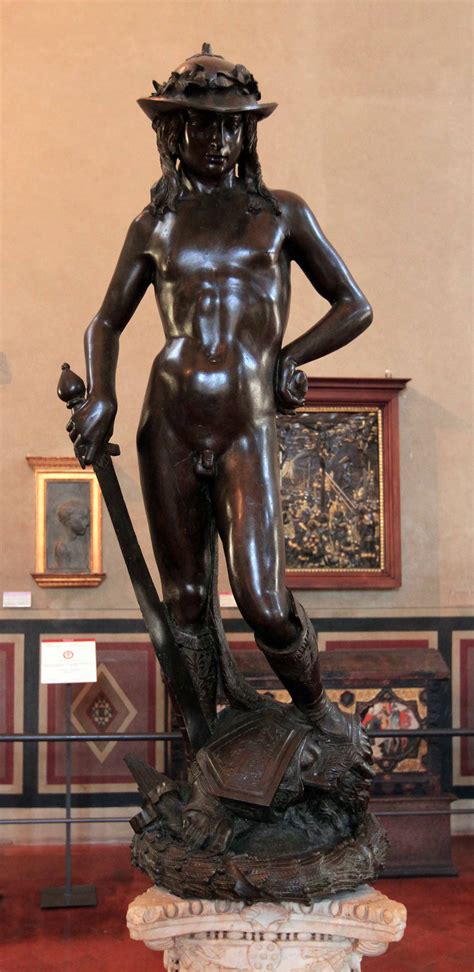
3. What David Represents
Donatello’s David represents a profound blend of religious symbolism and Renaissance humanism. As a depiction of the biblical hero who defeated Goliath, the statue embodies the triumph of intellect and faith over brute strength. David’s youthful, almost delicate appearance contrasts sharply with the powerful enemy he vanquished, highlighting the theme of divine intervention and the victory of the underdog.
Beyond its biblical narrative, David serves as a symbol of Florence’s civic pride and political strength. During the Renaissance, the city-state of Florence viewed itself as an underdog facing larger, more powerful adversaries. David’s victory over Goliath was an apt metaphor for Florence’s resilience and strategic prowess in overcoming its challenges. The sculpture became a representation of the city’s values and aspirations, resonating deeply with its citizens.
Additionally, Donatello’s interpretation of David reflects the Renaissance focus on individualism and the human form. The sculpture’s realistic anatomy and expressive details emphasize the beauty and potential of the human body, celebrating humanity’s intellectual and artistic achievements. In this way, David stands not only as a religious icon but also as a testament to the Renaissance spirit of exploration, innovation, and self-discovery.
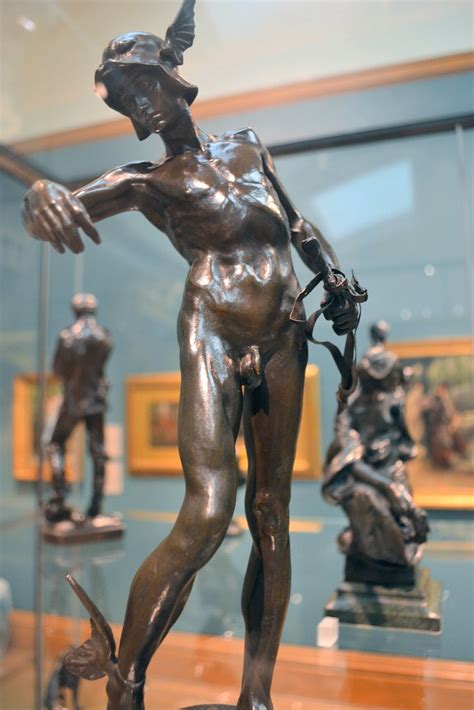
4. Why the Style is Revolutionary
The style of Donatello’s David is revolutionary due to its unprecedented approach to sculpture, blending classical influences with innovative techniques that marked a departure from the prevailing Gothic style. Donatello’s use of bronze for a freestanding nude figure was groundbreaking, as large-scale bronze statues were rare and technically challenging to create during the early Renaissance.
David’s contrapposto stance, where the weight is shifted onto one leg, introduced a naturalism and sense of movement that had been absent from medieval art. This pose, derived from ancient Greek and Roman sculptures, allowed for a more dynamic and lifelike representation of the human form. Donatello’s meticulous attention to anatomical details further emphasized this realism, showcasing his deep understanding of human physiology.
Moreover, the emotional expressiveness captured in David’s face and posture was a significant departure from the more rigid and idealized figures of the Gothic period. This focus on individual emotion and character aligned with the Renaissance humanist ideals, which celebrated the complexity and potential of the individual. Through these stylistic innovations, Donatello’s David set a new standard for sculpture, influencing countless artists and shaping the course of Western art.
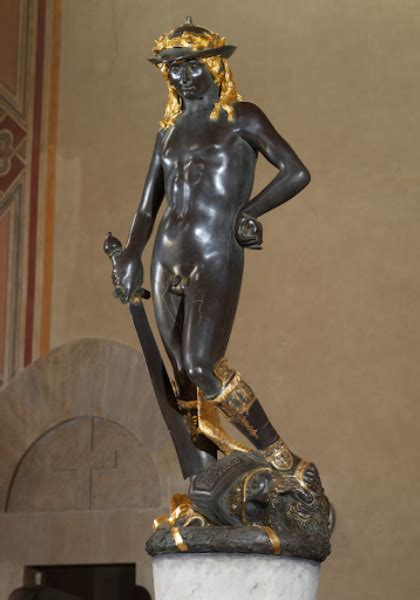
5. How David Influenced Art
Donatello’s David had a profound and lasting influence on the world of art, setting a new benchmark for Renaissance sculpture and inspiring future generations of artists. Its naturalistic portrayal of the human body, combined with the emotional depth and individuality of the subject, marked a significant shift from the idealized and static figures of the Gothic period. This emphasis on realism and humanism resonated deeply with Renaissance artists, encouraging them to explore similar themes in their work.
The sculpture’s innovative use of contrapposto and detailed anatomy influenced notable artists such as Michelangelo and Leonardo da Vinci, who further developed these techniques in their masterpieces. Michelangelo’s own David, created several decades later, reflects Donatello’s pioneering work in its lifelike form and powerful presence, demonstrating the enduring impact of Donatello’s approach.
Donatello’s success with bronze casting also opened new possibilities for sculptors, showcasing the material’s potential for intricate detail and dynamic compositions. This technical achievement inspired other artists to experiment with bronze, leading to an era of increased creativity and technical excellence in sculpture.
Overall, Donatello’s David played a crucial role in the evolution of Renaissance art, bridging the gap between classical inspiration and innovative expression, and leaving an indelible mark on the artistic landscape.
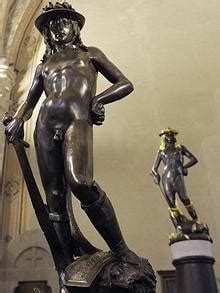
6. What Makes David Unique
Donatello’s David is unique for several reasons, distinguishing it from other artworks of its time and cementing its place in art history. Firstly, its status as the first freestanding nude male sculpture since antiquity reintroduced the classical appreciation of the human form. This bold choice was revolutionary, as it broke away from the heavily draped figures typical of the Gothic period.
The youthful and almost androgynous depiction of David sets it apart from traditional representations of the biblical hero as a muscular warrior. This portrayal emphasizes vulnerability and introspection, offering a more nuanced and humanized interpretation of David. The delicate details, such as the finely crafted hair and serene facial expression, contribute to the sculpture’s lifelike and intimate quality.
David’s contrapposto stance, with its realistic weight distribution and sense of movement, was a groundbreaking achievement in creating a dynamic and naturalistic figure. This pose, inspired by classical antiquity, adds a sense of grace and fluidity to the sculpture, enhancing its realism.
Additionally, Donatello’s mastery of bronze casting allowed for exceptional detail and finish, making David not only a technical marvel but also a visually striking piece. These elements combined make Donatello’s David a unique and iconic masterpiece that continues to captivate audiences.
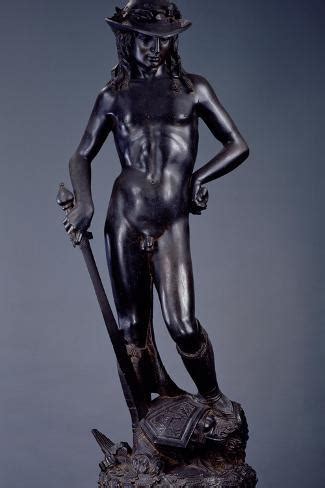
7. Why David is Celebrated Today
David is celebrated today for its groundbreaking impact on art and its enduring cultural significance. The sculpture represents a pivotal moment in the Renaissance, embodying the era’s renewed interest in classical antiquity and its emphasis on humanism. Its departure from medieval norms in favor of a more realistic and expressive portrayal of the human form marked a revolutionary shift in art, influencing countless artists and sculptors.
The innovative use of contrapposto, the attention to anatomical detail, and the lifelike quality of the bronze work set new standards in sculpture. Donatello’s David not only revived classical techniques but also introduced a fresh perspective on character and emotion, which resonated deeply with Renaissance ideals.
Today, David is celebrated for its aesthetic beauty and technical excellence, continuing to inspire artists and art lovers alike. It is hailed as a symbol of artistic innovation and human potential, showcasing the profound impact of Renaissance art on the course of Western art history. The sculpture’s presence in major art collections and exhibitions underscores its importance, allowing new generations to appreciate its significance and admire its masterful execution.
David remains a testament to Donatello’s skill and vision, celebrated as a timeless masterpiece that captures the essence of both its historical context and its enduring legacy.
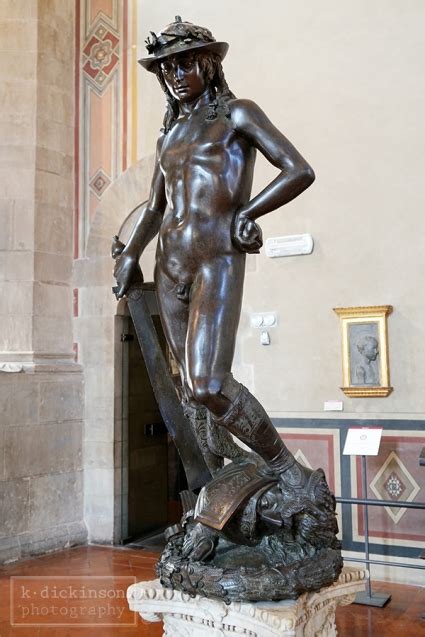
8. How to Appreciate David
To appreciate Donatello’s David fully, begin by examining its intricate details and craftsmanship. Observe the realistic depiction of David’s youthful form and the delicate features that set this sculpture apart from other representations of the biblical hero. Notice the contrapposto pose, which creates a naturalistic sense of movement and weight distribution, reflecting Donatello’s mastery of anatomy and dynamic composition.
Consider the historical context in which David was created. Understanding the significance of the Renaissance and Donatello’s innovative techniques helps to appreciate the sculpture’s impact on art history. Reflect on how the work embodies Renaissance humanism and the revival of classical ideals.
Engage with the sculpture’s symbolism, recognizing David’s role as a representation of Florence’s civic pride and resilience. This broader cultural and political significance adds depth to your appreciation.
Finally, viewing the sculpture in person, if possible, allows for a direct encounter with its materiality and scale, offering a more profound understanding of its artistic and historical importance.
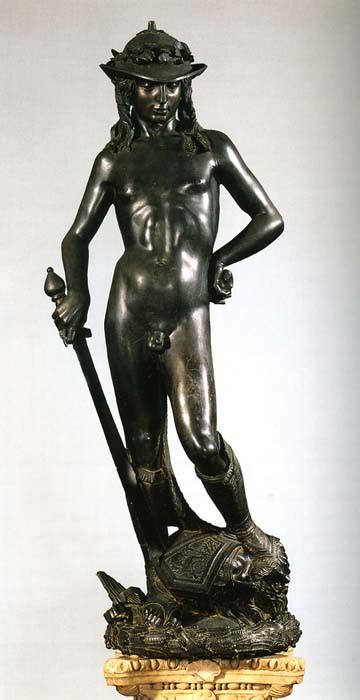
9. What to Expect in Exhibitions
When encountering Donatello’s David in exhibitions, you can expect a comprehensive exploration of its artistic and historical significance. Exhibitions often feature detailed displays that highlight the sculpture’s innovative techniques, such as the lost-wax casting process used to create the bronze figure. Look for informative panels or multimedia presentations that delve into the technical aspects and craftsmanship behind the sculpture.
Curators frequently provide contextual information about the Renaissance period, explaining how David represents a shift from medieval art to classical revival. You might find comparisons with other Renaissance artworks and sculptures, illustrating how Donatello’s work influenced and was influenced by his contemporaries.
Interactive elements, such as 3D models or digital reconstructions, may allow visitors to examine David’s details up close and from different angles. Educational programs, guided tours, and lectures may be offered to enhance your understanding of Donatello’s artistic vision and the cultural impact of the sculpture.
Special exhibitions might also include related artifacts or artworks from the same era, providing a broader perspective on the artistic and historical context of David. Expect a rich, immersive experience that deepens your appreciation of this iconic masterpiece.

Donatello’s David remains a masterpiece of Renaissance art, celebrated for its groundbreaking style and profound impact on art history. Through its innovative use of bronze, realistic anatomy, and symbolic depth, David exemplifies the era’s artistic revolution and humanistic ideals. Its enduring influence and continued recognition in exhibitions underscore its significance as a timeless symbol of creativity and artistic achievement. Appreciating David offers a deeper understanding of both Renaissance art and the legacy of Donatello’s genius.
gamesfats.com

